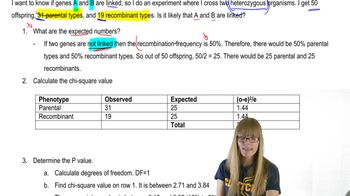In a test of his chromosome theory of heredity, Morgan crossed a female Drosophila with red eyes to a male with white eyes. The females were produced from Cross A, shown in the Figure below. Predict the offspring Morgan would have expected under his hypothesis that the gene for eye color is on the X chromosome in fruit flies.
Table of contents
- 1. Introduction to Genetics51m
- 2. Mendel's Laws of Inheritance3h 37m
- 3. Extensions to Mendelian Inheritance2h 41m
- 4. Genetic Mapping and Linkage2h 28m
- 5. Genetics of Bacteria and Viruses1h 21m
- 6. Chromosomal Variation1h 48m
- 7. DNA and Chromosome Structure56m
- 8. DNA Replication1h 10m
- 9. Mitosis and Meiosis1h 34m
- 10. Transcription1h 0m
- 11. Translation58m
- 12. Gene Regulation in Prokaryotes1h 19m
- 13. Gene Regulation in Eukaryotes44m
- 14. Genetic Control of Development44m
- 15. Genomes and Genomics1h 50m
- 16. Transposable Elements47m
- 17. Mutation, Repair, and Recombination1h 6m
- 18. Molecular Genetic Tools19m
- 19. Cancer Genetics29m
- 20. Quantitative Genetics1h 26m
- 21. Population Genetics50m
- 22. Evolutionary Genetics29m
2. Mendel's Laws of Inheritance
Sex-Linked Genes
Problem 6a
Textbook Question
In Drosophila, the map positions of genes are given in map units numbering from one end of a chromosome to the other. The X chromosome of Drosophila is 66 m.u. long. The X-linked gene for body color—with two alleles, y⁺ for gray body and y for yellow body—resides at one end of the chromosome at map position 0.0. A nearby locus for eye color, with alleles w⁺ for red eye and w for white eye, is located at map position 1.5. A third X-linked gene, controlling bristle form, with f⁺ for normal bristles and f for forked bristles, is located at map position 56.7. At each locus the wild-type allele is dominant over the mutant allele.
In a cross involving these three X-linked genes, do you expect any gene pair(s) to show genetic linkage? Explain your reasoning.
 Verified step by step guidance
Verified step by step guidance1
Understand the concept of genetic linkage: Genetic linkage occurs when two genes are located close to each other on the same chromosome, reducing the likelihood of recombination between them during meiosis. The closer the genes are, the stronger the linkage.
Identify the map positions of the three genes: The body color gene (y⁺/y) is at position 0.0, the eye color gene (w⁺/w) is at position 1.5, and the bristle form gene (f⁺/f) is at position 56.7 on the X chromosome.
Calculate the distances between each pair of genes: Subtract the map positions to determine the genetic distances. For example, the distance between the body color gene and the eye color gene is |1.5 - 0.0| = 1.5 m.u., and the distance between the eye color gene and the bristle form gene is |56.7 - 1.5| = 55.2 m.u.
Evaluate the likelihood of genetic linkage: Genes that are less than 50 m.u. apart are more likely to show genetic linkage because recombination is less frequent. In this case, the body color gene and the eye color gene are only 1.5 m.u. apart, so they are likely to show genetic linkage. However, the bristle form gene is much farther away from both the body color gene (56.7 m.u.) and the eye color gene (55.2 m.u.), so it is unlikely to show linkage with either of them.
Conclude which gene pairs are linked: Based on the distances, the body color gene and the eye color gene are expected to show genetic linkage due to their close proximity, while the bristle form gene is not expected to be linked to either of the other two genes because it is too far away.
 Verified video answer for a similar problem:
Verified video answer for a similar problem:This video solution was recommended by our tutors as helpful for the problem above
Video duration:
2mPlay a video:
Was this helpful?
Key Concepts
Here are the essential concepts you must grasp in order to answer the question correctly.
Genetic Linkage
Genetic linkage refers to the tendency of genes located close to each other on the same chromosome to be inherited together during meiosis. This occurs because linked genes are less likely to be separated by recombination events. The closer the genes are on the chromosome, the stronger the linkage, which can be measured in map units (m.u.). In the context of Drosophila, understanding linkage helps predict the inheritance patterns of traits controlled by these genes.
Recommended video:
Guided course

Chi Square and Linkage
Map Units (m.u.)
Map units, or centimorgans (cM), are a unit of measurement used in genetics to express the distance between genes on a chromosome. One map unit corresponds to a 1% chance of recombination occurring between two genes during meiosis. In the given question, the distances between the genes for body color, eye color, and bristle form are provided in map units, which are essential for determining the likelihood of genetic linkage among them.
Recommended video:
Guided course

Mapping Genes
Dominance and Alleles
Dominance refers to the relationship between alleles of a gene, where the presence of a dominant allele masks the expression of a recessive allele. In the context of the Drosophila genes mentioned, the wild-type alleles (y⁺, w⁺, f⁺) are dominant over their respective mutant alleles (y, w, f). Understanding dominance is crucial for predicting phenotypic outcomes in genetic crosses, especially when considering how linked genes may influence trait inheritance.
Recommended video:
Guided course

Variations on Dominance
Related Videos
Related Practice
Textbook Question
518
views


